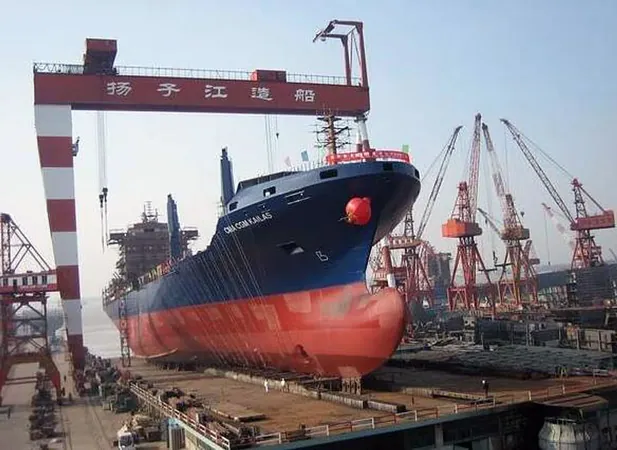
Will Yangzijiang Shipbuilding's Share Price Slip Prove Temporary?
2025-04-01
Author: Wei
Overview of Recent Developments
The recent proposal by the United States to levy hefty port fees on Chinese-built or operated ships has sent shockwaves through Yangzijiang Shipbuilding’s stock, which has plummeted nearly 30 percent. The striking changes came after the U.S. announced a potential imposition of fees reaching as high as US$1.5 million for Chinese-operated vessels, causing a swift retraction in the shipbuilder's share price.
Share Price and Market Dynamics
Starting from a peak of S$3.30 on February 20, 2023, after a steady rise from S$1.70 since May 2022, the company now finds itself facing challenging waters. Analysts are closely watching how these shifts will affect Yangzijiang, especially in light of the proposed structure of the fees which varies based on the percentage of Chinese-built vessels in a fleet.
U.S. Scrutiny on Chinese Shipping
This movement is part of a broader scrutiny by the U.S. regarding China's dominance in global shipping, which has skyrocketed over the past two decades. A recent report highlighted that China's share of global shipbuilding tonnage surged to over 50 percent as of 2023, a stark rise from just 5 percent in 1999.
Analysts' Perspectives
DBS Equity Research noted that Yangzijiang stands as the only significant shipbuilding company in the region experiencing this turmoil, with its Chinese competitors largely remaining unscathed. They emphasize the current sell-off may not fully reflect the firm’s potential and suggest investors seize this moment as a strategic buying opportunity, projecting a target price of S$3.80.
Future Outlook for Yangzijiang
Their analysis indicates that existing shipyards are booked solid for the next three years, providing Yangzijiang ample time to adjust to any policy shifts. The firm’s resilient standing is further backed by an increasing demand for various vessels due to trends in fleet rejuvenation and a rise in defense-related shipbuilding.
Management's Report and Market Response
Despite the storm caused by impending fees, Yangzijiang’s management reported no cancellations or delays in orders as of late February, and analysts suggest the port costs could be passed on to cargo owners, meaning that shipping companies might not bear the full brunt of the fees. UOB Kay Hian reported that the estimated fees could translate to about US$100 per container, potentially manageable for the larger shipping lines.
Shifts in Chinese Shipbuilding Strategies
Moreover, in response to the rising tensions, Chinese shipbuilders are exploring alternative strategies, including shifting routes, forming partnerships, or relocating production facilities outside of China, a trend some analysts are dubbing "China plus N"—a sign of increasing diversification in global supply chains.
Long-term Implications
There’s a consensus among economists that these proposed levies signal a long-term strategy for U.S. policymakers to reduce reliance on Chinese manufacturing, suggesting that Yangzijiang and similar companies may face continued scrutiny. The potential for increased freight costs could prompt carriers to consider using non-Chinese vessels, a move that could shield them from the adverse effects of rising port fees.
Conclusion
So, while the recent plunge in Yangzijiang's share price raises valid concerns, many analysts remain optimistic, labeling this moment a tactical opportunity for savvy investors who are ready to navigate the treacherous waters of global shipping regulation. As the situation develops, all eyes will be on Yangzijiang to see if the tide turns back in their favor, making this a critical juncture for the future of shipbuilding in China.



 Brasil (PT)
Brasil (PT)
 Canada (EN)
Canada (EN)
 Chile (ES)
Chile (ES)
 Česko (CS)
Česko (CS)
 대한민국 (KO)
대한민국 (KO)
 España (ES)
España (ES)
 France (FR)
France (FR)
 Hong Kong (EN)
Hong Kong (EN)
 Italia (IT)
Italia (IT)
 日本 (JA)
日本 (JA)
 Magyarország (HU)
Magyarország (HU)
 Norge (NO)
Norge (NO)
 Polska (PL)
Polska (PL)
 Schweiz (DE)
Schweiz (DE)
 Singapore (EN)
Singapore (EN)
 Sverige (SV)
Sverige (SV)
 Suomi (FI)
Suomi (FI)
 Türkiye (TR)
Türkiye (TR)
 الإمارات العربية المتحدة (AR)
الإمارات العربية المتحدة (AR)